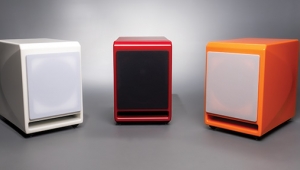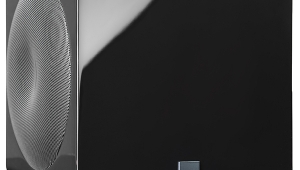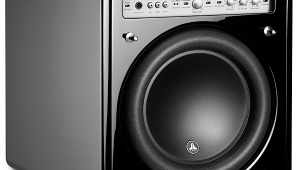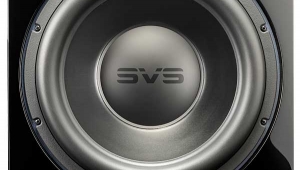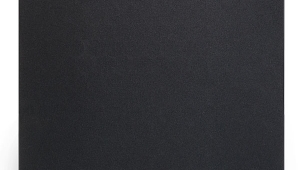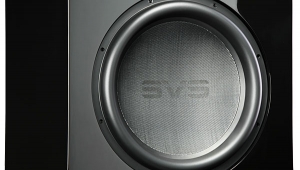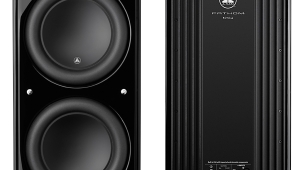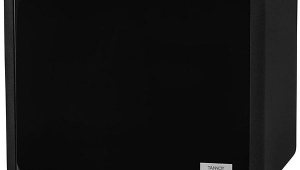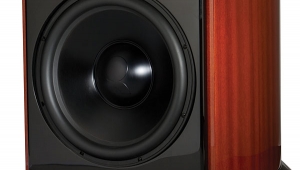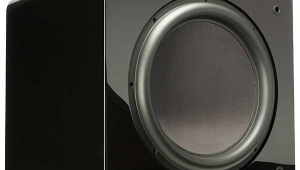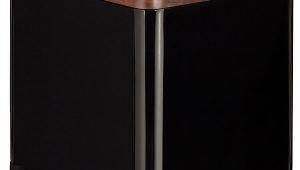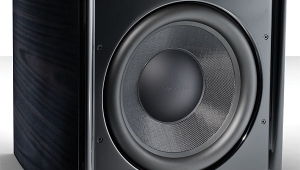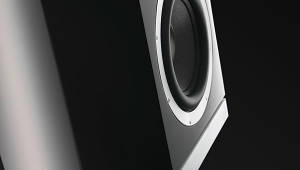| Columns Retired Columns & Blogs |
MartinLogan BalancedForce 212 subwoofer Page 2
We listened to several more cuts, only adjusting the overall sub levels a tad, and decided that, out of the box, the BF212s sounded great. We'd been listening at fairly loud levels; only later, when I went upstairs, did I realize how deeply the BF212s had been shaking the house: all the pictures on the second floor were crooked and had to be re-leveled—a process that occurred regularly throughout the listening period, and forced us to Blu-Tack the things to the walls.
Footnote 1: Kal Rubinson wrote about using Perfect Bass Kit in January 2010.—Ed.
Set the Controls for the Heart of the Sub
Back in my Velodyne ULD-15 days, I had a big volume knob to play with, and that was it. MartinLogan's Descent i had several more knobs. And now, to those, the new BalancedForce 212 adds a couple of buttons.
On the top of each BF212 is a removable, 13.5" by 3.5" plate of smoked glass. Glowing up through it is an illuminated MartinLogan logo, and below that is an On/Dim/Off toggle. Below the logo is a column of four knobs: Level (goes to 11!!); 25Hz Level (dB); Low-Pass Filter (Hz), which ranges from 30 to 80Hz; and Phase, with four positions selectable in between.
Below the four knobs is another three-way toggle with status LED for setting the Mode: On, Auto (12V Trigger), or Off. For the review, I left this switch in the Auto position, which saves energy, turning the sub on only when it detects music, and off again after several minutes of silence. A side effect of this was that there was a soft clack, about the loudness of a light finger snap, every time the BF212 powered up—somewhat distracting with music that begins softly. With two subs in my system, it was always clack clack, first thing each day. (The Descent i does the same thing, though a bit more quietly.)
Below the Mode switch are three buttons. Pressing Tone Sweep activates a built-in low-frequency tone generator that repeats until you press it again, at which point it holds that frequency. This is helpful for manually tweaking the subwoofer level, and especially handy for finding which frequencies excite rattles in your room.
The other two buttons provide real advantages over my Descent i's. Custom Low-Pass lets you load a custom crossover setting, based on the model of MartinLogan speaker (if any) in the system. I went to ML's website, found the download for the Prodigy, put it on a USB stick, and plugged the stick into the port on the back of each BF212. When that's done, the Custom Low-Pass settings disable that BF212's Low-Pass Filter knob.
The last button, Room EQ, engages the Perfect Bass Kit (detailed below) compensation curve, once that calibration has been done and the resultant equalization (EQ) curve has been uploaded to the BF212. You can toggle the custom EQ off and on, for comparison. MartinLogan says that having a Custom Low-Pass installed will not affect the PBK measurements and resulting EQ.
Baby Got Back
On the bottom of the BalancedForce 212's large, metal rear panel, from the left, are: the power connector jack; balanced Left, Right, and LFE inputs (XLR); unbalanced Left, Right, and LFE/Multi line-level inputs (RCA); and an unbalanced Multi output (RCA). Above the four RCA jacks are: a USB port for loading the Custom Crossover settings and firmware updates via USB stick, the PBK mini-USB input jack, and a trigger input (5–24VDC). Above these are USB and Power status LEDs.
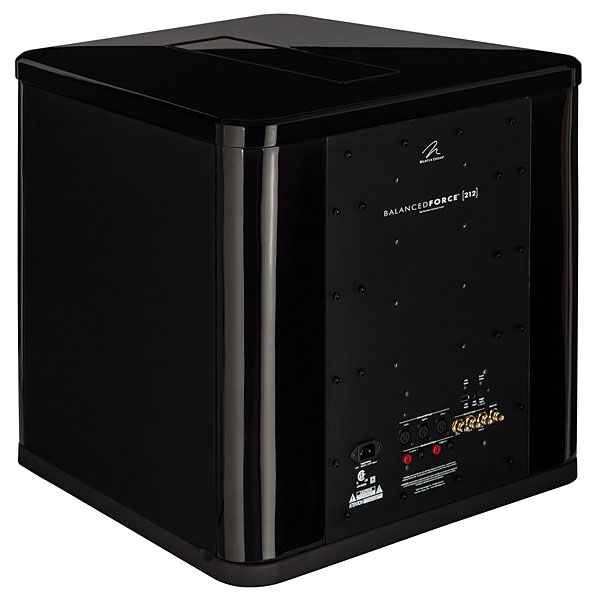
Attached to the inside of that rear plate are two 850W, class-D switching amplifiers (the BF210 has one amp). That's one amp per 12" aluminum-cone woofer, or 1700W total. I had two BF212s in the room, which added up to 3400W of powered bass! Good thing I had them on a dedicated 40-amp circuit, though MartinLogan claims that each sub typically draws about 250W. The BF212 has high-power transformers and switching power supplies for efficiency, along with MOSFET transistors. When the subs were on, their rear panels were warm to the touch.
If you're running a single BF212, you can use its Left and Right balanced XLR or unbalanced RCA inputs, or the balanced or unbalanced LFE inputs. If you have a two-channel listening system that doubles at times as a surround movie system, you can run both types of inputs (Left and Right for stereo, LFE for movies), and set independent volumes for each. If using a BF212 only for surround listening, the LFE is probably all you need—in which case, the crossover knob on top is bypassed, as this will be set by your preamplifier-processor.
But if you run two BF212s, as I did, things get a bit more complicated. The manual has instructions for running up to four BF212s in a master/slave arrangement in which you use the Multi-In/Out jacks and daisy-chain each sub. But I was running two subs in stereo, as explained above, which the manual doesn't cover. So after confirming with MartinLogan, I set up the 212s as I had the Descent i's: I simultaneously ran each channel's full-range signal to a monoblock's input and to the left-channel input of one of the subs.
Perfect Bass Kit
I could have lived with the BalancedForce 212s straight outa their boxes, but MartinLogan had also sent along their Perfect Bass Kit, or PBK ($100, footnote 1), which consists of a small calibrated microphone with telescoping stand, two 12' USB cables, and software on a disc. There was only one problem: the software is Windows-only, and my laptop is a Mac. My only Windows machine—a Mac that can boot up in Windows 7—is a desktop model at the other end of the house.
After learning that most members of our audio club also have Apples, I found one guy whose Dell laptop runs Windows Vista. He came over, and we downloaded the latest PBK software, but could never get the program to go past the first tone sweep. MartinLogan suggested disabling the laptop's virus software, switching to a powered USB hub, etc. No go. Some more e-mails to some more pals and, another, newer PC later—this one with Windows 7—we were finally up and running.
Once everything is plugged in and the PBK software is opened, you're asked for your mike's serial number. Each mike has been calibrated at the ML factory—the software is tuned to your particular mike. You run the test routine for multiple mike positions (a minimum of five is recommended; the max is ten), and then the software plots on a graph the resultant Measured, Target, and Calculated frequency-response curves, and uploads the new compensation EQ curve to your sub (fig.1).
After we'd done this for both subs, one at a time and several times each, we noted that consistent Measured and Calculated plots were recorded each time. The final Calculated response curves after the EQ was applied were flat to within 1dB across the subwoofers' useful range of 20–160Hz. Nice!
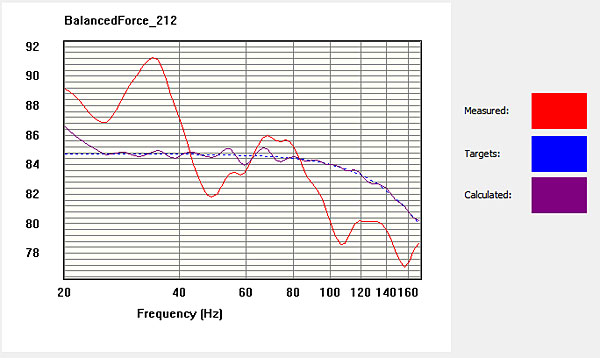
Fig.1 Perfect Bass Kit, measured (red), target (blue), and calculated (purple) frequency responses (0.4dB/vertical div.).
MartinLogan has a helpful video online that runs through the process, making it dead simple (once you find a PC laptop that will work). I can't imagine not getting the PBK if you get a BalancedForce sub, especially for only $100.
However, since I set up stereo subs, which helps smooth out standing waves in a room and creates a result at the listening position that differs from that of a single sub, I would have preferred some way to work with the subs as a pair, in addition to tweaking one at a time. At the end of the calibration, to balance the bass with the rest of the music, I had to adjust the overall sub levels by ear.
Big Box Roar
With PBK applied and the Custom Low-Pass filter for my Prodigy speakers uploaded, I was ready for some hearty listening. All the usual bass-heavy suspects made the rounds: Morcheeba, Massive Attack, Bill Laswell, Steve Roach, plenty of recent electronica, large orchestras—and, of course, "Big Bottom," from This Is Spinal Tap (CD, Polydor 8178462); and "Baby Got Back" (which inspired the parody that opens this review), from Sir MixaLot's Mack Daddy (CD, American 5101173792).
The BalancedForce 212s passed all of these auditions, and more, with flying colors. But since towering slabs of bass aren't the whole story, I dug into more classic fare, where an unruly bottom can ruin an otherwise well-balanced mix.
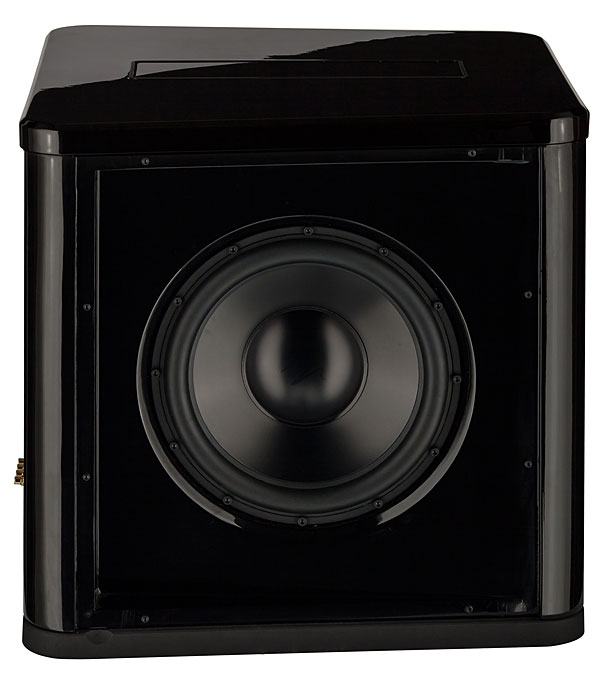
Led Zeppelin's first three albums have been remastered and are available as 24-bit/96kHz downloads from HDtracks and elsewhere. These are gritty recordings with heavy compression and warts all over the place, but somehow, they still trounce most modern rock productions—and I love the new versions. I cued up "What Is and What Should Never Be," from II.
With the BF212s, the kick drum and bass were tuneful and heavy, bouncing me firmly on the couch every time the band's full force kicks in on the chorus. Yet there was no sense of bloat or bass "effect," and the tonal balance from top to bottom just felt right and real. All the heft and impact that I was used to with the Descent i's was still there, yet the bottom end was now doing a better job of getting out of the way of the rest of the music.
I was wondering if the two 12" drivers in each BF212 could keep up with the three smaller, and therefore theoretically quicker, 10" woofers in each Descent i. So I pulled out audio-show staple "Wish You Were Here," from Seguridad Social's Furia Latina (CD, WEA International 92317), which is a bit lean in the bass department, but has a lively, dynamic sound. In this case, the Descents' woollier upper bass worked better overall with the leaner mix, and the kick drum felt a tad quicker. However, the BF212s laid out the bass guitar with more authority and rendered the instrument more realistically, and more distinctly in the mix. I'd call it a draw.
One thing that many of us won't allow a subwoofer to do is to add any hint of colorization to the sounds of voices. Azam Ali is a Persian singer whose album Elysium for the Brave (CD, Six Degrees 6570361130) spotlights her clear, bell-like voice, which she flecks with Middle Eastern trills and ululation. Though the recording is packed with percussion and stringed instruments, in no sense did the BF212s intrude on the pure sound of Ali's voice. This was the case with everything from rock screamers to the standard audiophile jazz ballads.
Big Bottom Line
Trying to recall what I did not like about MartinLogan's BalancedForce 212, I come up almost empty. The clack clack on turn-on is distracting, and the manual and PBK could do a better job of addressing systems set up for two stereo subwoofers. That said, the quick, tight BalancedForce design and complete range of adjustments, with the ability to make the BF212's response flat in almost any environment, has yielded a product with few sonic faults.
With contemporary music, and much jazz and classical, there was a tactile presence to the bottom end with the BF212s that is missing from the sounds of most large, floorstanding speakers, let alone anything smaller. As Craig noted when he dropped by later for more listening, the BF212s were "very honest to whatever kind of music you chose to play." I'm not just talking about more bass, but the pressure and physicality of air moving quickly in a room. With those recordings whose engineers had been able to get this down on tape or into the digits in the first place, the BalancedForce 212s restored it to my experience of most music without bloat, and without sounding artificially pumped up.
If you can swing the cost, run stereo subs that can be calibrated with a mike in your room. The BalancedForce 212s are so flexible that I can imagine them—used in almost any room, and with almost any speaker—restoring the tactile impact and low-end reach that other subs usually leave by the door.
I've come to love what my two Descent i's can do. But I've often had trouble tuning the system's balance to that precise point where the bass is full but gets out of the way of everything else. This the BalancedForce 212s with PBK did quite well. Whether or not you have MartinLogan speakers to pair them with, I strongly, strongly recommend the BalancedForce 212. It's definitely not a tubby thumper, and no imagination is needed, because nothing is missing.
Footnote 1: Kal Rubinson wrote about using Perfect Bass Kit in January 2010.—Ed.
- Log in or register to post comments
